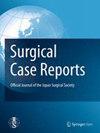A case of refractory chylothorax due to an unenclosed esophageal hiatus after subtotal esophagectomy treated with lipiodol lymphangiography
IF 0.7
Q4 SURGERY
引用次数: 0
Abstract
Chylothorax, a rare but serious complication following esophagectomy, can lead to dehydration, malnutrition, and even mortality. Surgical intervention is considered when conservative treatment is ineffective; however, in some refractory cases, the cause of chylothorax remains unclear. We report a case of refractory chylothorax caused by abdominal chyle leakage into the pleural space via an unenclosed esophageal hiatus. A 66-year-old man was diagnosed with advanced esophageal squamous cell carcinoma. The patient underwent robot-assisted thoracoscopic subtotal esophagectomy in the prone position with retrosternal gastric tube reconstruction following neoadjuvant chemotherapy. The thoracic duct was ligated and resected because of tumor invasion. Chylothorax and chylous ascites were observed 2 weeks after surgery but did not improve despite conservative management with medications and drainage. Lymphoscintigraphy through the inguinal lymph node showed tracer accumulation in the fluid in both the abdominal and pleural spaces. Lipiodol lymphangiography revealed abdominal lymphoid leakage, but no leakage was detected from the thoracic duct or mediastinum. We considered that the chylothorax was caused by chylous ascites flowing into the pleural space via an unenclosed esophageal hiatus, and we performed surgical intervention. Laparotomy revealed abdominal chyle leakage and a fistula at the esophageal hiatus with the inflow of ascites into the thoracic cavity. Lipiodol lymphangiography was additionally performed for treating abdominal lymphorrhea after surgery, and resulted in the improvement of the chylothorax and ascites. The patient was discharged with no recurrence of chylothorax or chylous ascites. Refractory chylothorax can occur due to chylous ascites flowing into the pleural space via an unenclosed esophageal hiatus. When the site of chylothorax leakage is unclear, the possibility of inflowing chylous ascites via the unenclosed esophageal hiatus should be explored. Esophageal hiatus closure and lipiodol lymphangiography could be effective in treating refractory chylothorax of unknown cause after esophagectomy.一例食管次全切除术后因食管裂孔未闭合而导致的难治性乳糜胸,采用脂肪碘淋巴管造影术进行治疗
乳糜胸是食管切除术后一种罕见但严重的并发症,可导致脱水、营养不良甚至死亡。当保守治疗无效时,就会考虑手术干预;然而,在一些难治性病例中,造成乳糜胸的原因仍不明确。我们报告了一例因腹腔糜烂通过未闭合的食管裂孔渗入胸膜腔而导致的难治性乳糜胸。一名 66 岁的男性被诊断出患有晚期食管鳞状细胞癌。患者在接受新辅助化疗后,在俯卧位接受了机器人辅助胸腔镜下食管次全切除术,并进行了胸骨后胃管重建。由于肿瘤侵犯,胸导管被结扎并切除。术后两周出现了乳糜胸和乳糜腹水,尽管通过药物和引流进行了保守治疗,但情况并未好转。腹股沟淋巴结淋巴管造影显示,腹腔和胸腔积液中均有示踪剂积聚。脂肪碘淋巴管造影显示腹腔淋巴管渗漏,但未发现胸导管或纵隔渗漏。我们认为,乳糜胸是由乳糜腹水经未闭合的食管裂孔流入胸膜腔引起的,因此进行了手术治疗。腹腔镜手术显示腹腔糜烂渗漏,食管裂孔处有瘘管,腹水流入胸腔。术后为治疗腹腔淋巴结肿大,又进行了脂肪碘淋巴管造影,结果改善了乳糜胸和腹水。患者出院后未再出现乳糜胸或乳糜腹水。难治性乳糜胸可能是由于乳糜腹水通过未闭合的食管裂孔流入胸膜腔所致。如果不清楚乳糜胸腔渗漏的部位,则应探讨乳糜腹水通过未闭合的食管裂孔流入胸腔的可能性。食管裂孔闭合术和脂肪碘淋巴管造影术可有效治疗食管切除术后原因不明的难治性乳糜胸。
本文章由计算机程序翻译,如有差异,请以英文原文为准。
求助全文
约1分钟内获得全文
求助全文

 求助内容:
求助内容: 应助结果提醒方式:
应助结果提醒方式:


